Letter from John Carson to Robert McPherson

John Carson writes to Robert McPherson, a member of the Board of Trustees, and discusses Charles Nisbet's qualifications as a candidate for President of Dickinson College.


John Carson writes to Robert McPherson, a member of the Board of Trustees, and discusses Charles Nisbet's qualifications as a candidate for President of Dickinson College.
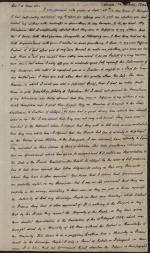
Charles Nisbet writes Ashbel Green to acknowledge Green's letter from September 12th and to justify questions about Green's intent in giving Nisbet's private letters to his political opponents.

This memorandum by David Stewart Erskine, the Earl of Buchan, was apparently at one time covering note for a number of letters from Dickinson College President Dr. Charles Nisbet to Erskine.
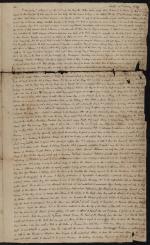
Dickinson College President Charles Nisbet writes to Dr. Jonathan Ingham of Bucks County, Pennsylvania with reflections on education, politics, international affairs, as well as other contemporary American issues. Transcript included.

John Erskine writes to Dickinson College President Charles Nisbet with news of home and a list of books that he will send for "your College library." Erskine also mentions a letter from Dr.

Professor Montgomery Porter Sellers writes to Augustine Birrell, the Chief Secretary for Ireland, and describes an observance of "Nisbet Day" that morning at Dickinson College, explains how Charles Nisbet became the first President of Dickinson, a
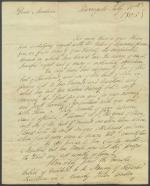
Charles Keith writes to Anne Nisbet regarding the death of her husband. "One of the best of Men is forever lost to his Friends and Mankind," as Keith observes. Keith also explains his decision to write Monody to the Memory of the Rev.

Charles Nisbet writes to Selina Hastings, the Countess of Huntingdon, about Methodist leader John Wesley's success in England and other related religious issues.
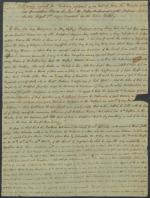
The testimony of Charles Nisbet against the doctrines contained in an extract from the minutes of some late conversation between Reverend John Wesley and others at a public conference in London on August 7, 1770. Transcript included.

Charles Nisbet writes to the Minister of Drumelzier and inquires about various events since his visit three months ago. Nisbet also requests updates on several ministers as well as a few other individuals. "Does [Mr.

Benjamin Rush writes to Thomas Smith of Carlisle, Pennsylvania regarding efforts to raise funds for Dickinson, including a petition to the Pennsylvania legislature for additional financial support. Dr.

Attorney Samuel Duncan sends this printed legal notice to Charles Nisbet, informing Nisbet that the house and lot he occupies are the property of John and Richard Penn.

Charles Nisbet writes to his son Alexander, an attorney in Baltimore, MD. Nisbet discusses Alexander's recovery from influenza, problems facing universities and colleges, and the health of his family. Transcript included.

Charles Nisbet writes to his son Alexander, an attorney in Baltimore, and offers advice on various topics. "Taverns," as Charles explains, are "the slaughter-houses of the most part of the youth of this country" and should be avoided.
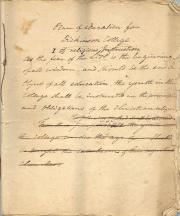
The papers of the Board of Trustees of Dickinson College, 1783-1833, include correspondence, reports, financial statements, printed materials, and legal documents, and have been arranged into seven series.
Series 1 – Membership contains correspondence regarding membership on the Board of Trustees, as well as a membership list, c1826.
Series 2 – Reports of the President consists of reports made to the Board by Presidents Nisbet, Davidson, and How.
Series 3 – General Business contains materials such as correspondence between trustees, mandamus to the faculty, and committee reports.
Series 4 – College Personnel includes correspondence to and from faculty members, including presidents.
Series 5 – Physical Plant contains land deeds and construction and service bills for the campus buildings.
Series 6 – Financial Affairs contains reports of the treasurer, subscription lists, and other financial materials.
Series 7– Publications contains printed materials such as college catalogues.
A fuller description of each series is given before each series inventory.
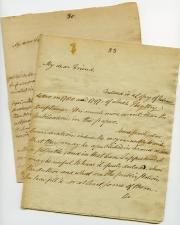
This collection is comprised of correspondence and legal papers reflecting the legal and political career of John Dickinson, statesman and president of the Supreme Executive Council of Delaware and Pennsylvania. The majority of the collection is comprised of correspondence from Dickinson to such prominent individuals as James Wilson, Caesar Rodney, and Benjamin Rush. The collection also contains financial papers and papers related to Dickinson's public duties, particularly to his duties as president of the Supreme Executive Council of Pennsylvania.

Francis Gurney (1738-1815) was a veteran of the French and Indian Wars, the American Revolution, and the Whiskey Rebellion. A prominent Philadelphia merchant, Gurney held several political offices such as city Alderman and representative and senator to the state legislature. Gurney also served as a trustee of Dickinson College from 1798 until his death in 1815; the majority of the collection reflects his service to the College, particularly in soliciting funds in Philadelphia under the direction of Treasurer John Montgomery.

The collection consists of the papers of Charles Nisbet, first president of Dickinson College, and his family, particularly his son-in-law, William Turnbull. The majority of these papers is correspondence conducted between Nisbet and his daughter, and also between Nisbet and Lady Leven of Scotland. The business ventures of William Turnbull are reflected through legal, financial, and other miscellaneous documents; the collection's single artifact is Turnbull's leather wallet.

The Presidents 1783-1833 Record Group contains papers related the presidency of the seven men who served at Dickinson from 1783 to 1833. This Record Group corresponds with that of RG 1/1, the Trustees 1783-1833, which also documents the first fifty years of the college. The materials in this record group pertain to the president’s duties in the administration of his office; any papers relating to his employment such as letters of acceptance or resignation and vouchers for salary are housed in RG 1/1. In addition, personal papers of the presidents have been removed to individual collections where applicable. The majority of the papers in this record group are correspondence with individual trustees regarding college business; also included are reports and resolutions from the faculty, as well as drafts of publications dealing with the curriculum.
Below is a timeline of the presidents of Dickinson College from 1783 to 1833.
1785 – Charles Nisbet
1785-1786 – Robert Davidson (acting)
1786-1804 – Charles Nisbet
1804-1809 – Robert Davidson
1809-1815 – Jeremiah Atwater
1815-1816 – John McKnight
1816-1821 – College closed
1821-1824 – John Mitchell Mason
1824 – Alexander McClelland (acting)
1824-1829 – William Neill
1829-1832 – Samuel Blanchard How
1832-1833 – College closed

This collection is mostly comprised of correspondence received by Philadelphia printer William Young from Charles Nisbet, President of Dickinson College. Young was a scotsman who settled in Philadelphia and set up a bookshop, a printing press, and later, a paper mill. As the president of a fledgling college, fellow scotsman Nisbet wrote frequently to Young upon a wide variety of topics, ranging from Nisbet's transactions with Young as a printer and book dealer, to local events and world news. The collection also contains other letters to Young from various clients, as well as one letter from Young to his wife.